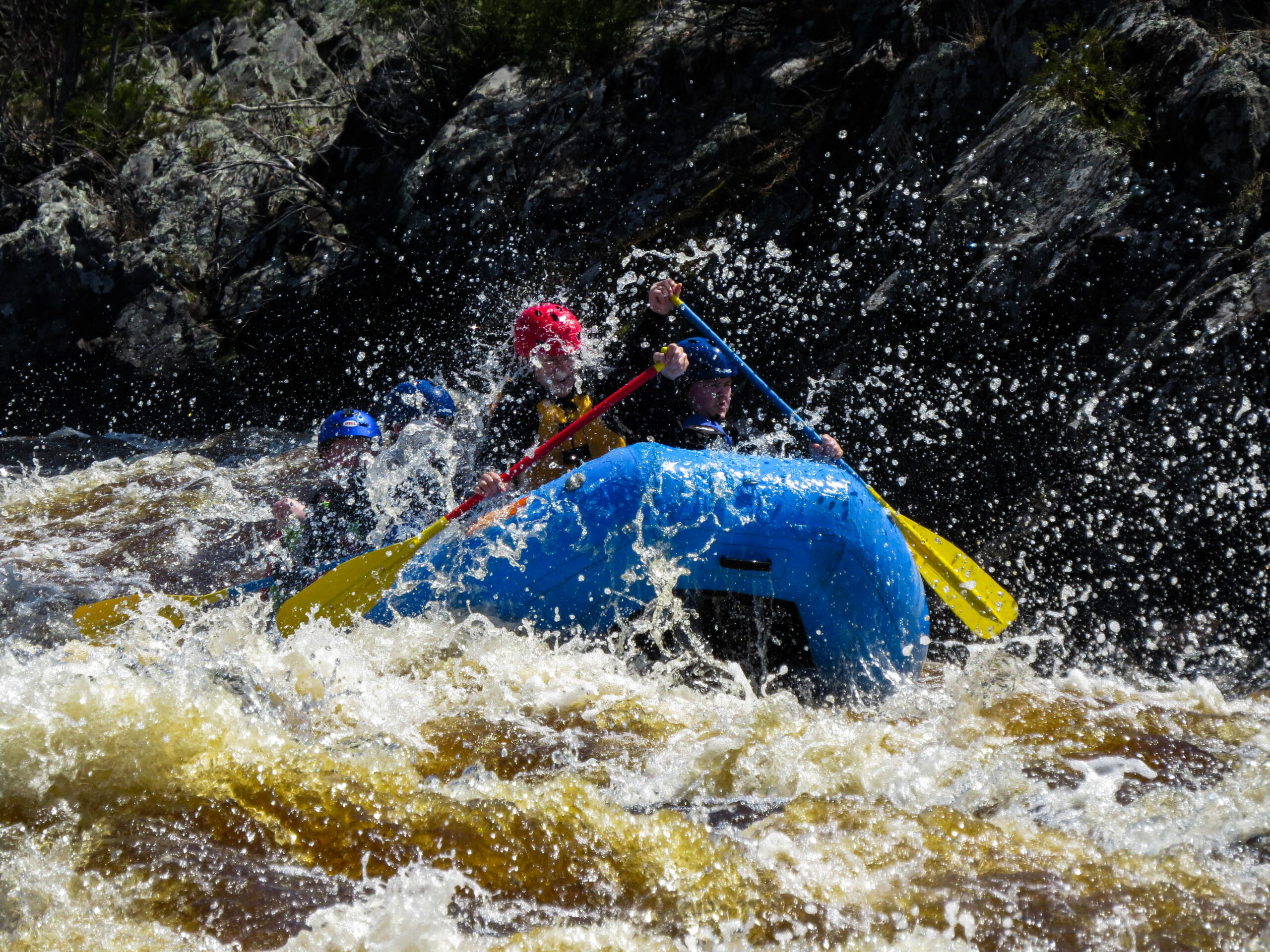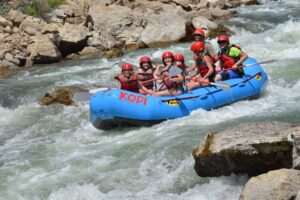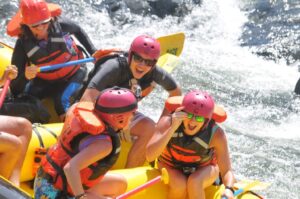White water rafting involves navigating rapids on an inflatable raft with a team of people and a guide. If you’re looking for an adrenaline-filled adventure, white water rafting may be just the activity for you.
This popular outdoor pursuit involves navigating a river’s rapids on an inflatable raft with a team of people and a guide. Each person on the raft must work together to maneuver the boat safely through the rushing water. White water rafting can vary in difficulty, ranging from easy and leisurely trips to more challenging, heart-pumping journeys.
It is a thrilling way to experience nature, improve teamwork skills, and create unforgettable memories with friends or family. In this article, we will explore the basics of how white water rafting works and what to expect on a white water rafting trip.

Credit: discovervail.com
The Science Behind White Water Rafting
White water rafting is an exciting outdoor water adventure where a team of rafters navigate through rapids and white water while immersed in the thrill of the ride. It’s not all about the adrenaline rush; there’s a science behind white water rafting that makes it both exciting and safe.
Understanding Rivers And Their Classifications
To understand white water rafting, one must first know what a river is. A river is any natural flowing watercourse that moves in a specific direction, such as a stream, creek or a brook. Rivers are classified into different categories based on their speed, gradient, and depth.
The six classes of rivers used in white water rafting classification are:
- Class i: This classification represents easy moving water with few obstructions and gentle waves.
- Class ii: This river classification represents novice rafting conditions with straightforward rapids and normal waves
- Class iii: This classification represents intermediate rafting conditions with waves, occasional rapids, and maneuvering required.
- Class iv: This classification represents expert rafting conditions with more challenging rapids, turbulent water, and turbulent waves.
- Class v: This classification represents extreme rafting where frequent rapids with high waves and complex maneuvering become necessary.
- Class vi: This river classification represents the highest level of difficulty, dangerous to raft, and best suited for experienced paddlers.
Categories Of Rivers And Their Characteristics
Rivers are categorized based on their speed, gradient, and depth. Understanding a river’s characteristics can play a significant role in the success and safety of your white water rafting trip.
- Speed: The speed of a river refers to how quickly the water is flowing. Faster-moving water typically creates more turbulence and produces stronger currents.
- Gradient: The gradient refers to the slope of the riverbed over a particular distance. A steep gradient typically indicates faster-moving water and more significant rapids.
- Depth: River depth is determined by measuring the vertical distance from the highest point to the river bottom. Shallow rivers are generally safer and less turbulent.
Identifying The Appropriate River To Raft On
Choosing the right river to raft on is an integral part of a successful and safe white water rafting trip. It’s essential to consider your skill level, the classification of the river, and the river’s characteristics. Experienced paddlers often seek rivers with higher classification levels and faster currents, while novice paddlers seek less challenging rapids with calmer waters.
The Physics Of Rafting
White water rafting involves overcoming the forces of nature, including gravity and water volume. Understanding these forces can help you master the techniques necessary to navigate through the rapids safely.
- Gravity: Gravity is the force that pulls objects towards the center of the earth and plays a crucial role in white water rafting. The gravitational force pulls water downhill, creating rapids and waves that require maneuvering by the paddlers.
- Water volume: The volume of water in a river is another factor that affects white water rafting. During seasons with heavy rainfall, the water levels can rise significantly, resulting in more challenging rafting conditions.
The Formation Of Rapids And The Impact On Rafting
Rapids are formed when water flows over an obstacle, and the speed and volume of the water increase. As the water flows over and around the obstacles, it begins to create eddies, waves, and whirlpools. These natural river features require experience and skill to navigate successfully.
The formation of rapids affects white water rafting by creating more speed and turbulence, requiring paddlers to navigate through more complex maneuvers.
White water rafting is an exciting and thrilling adventure that requires understanding the underlying science of rivers and their classifications. Identifying the appropriate river to raft on and mastering the forces of gravity and water are crucial for a safe and successful trip.
The formation of rapids adds to this excitement, but it requires experience and skill. By adhering to safety guidelines and practicing the necessary techniques, white water rafting can be an enjoyable and memorable experience.
The Mechanics Of White Water Rafting
White water rafting is an incredibly exciting and adventurous activity that involves navigating through rough rapids and currents on a raft. It is a great sport for those who love to feel their adrenaline pumping and who want to challenge themselves physically and mentally.
If you’re wondering how white water rafting works, then keep reading this post. In this section, we will discuss the mechanics of white water rafting.
Equipment Required
Rafting requires a set of specialized equipment to ensure your safety and comfort. The main pieces of equipment you’ll need when rafting are rafts, paddles, helmets, and life jackets.
- Rafts: Rafts are specially designed boats that come in different sizes, depending on the number of people riding it. They are made of sturdy materials that can withstand the impact of hitting rocks and obstacles in the river.
- Paddles: Without paddles, you wouldn’t be able to navigate through the rapids. Paddles work as rudders, allowing you to steer in the right direction. They come in different sizes, depending on the user’s height and the type of water you’re navigating.
- Helmets: Helmets are a must-have when white water rafting. They protect your head from any potential collisions with rocks or other objects in the water.
- Life jackets: A life jacket is essential because it helps you stay afloat if you fall in the water, especially in rough waters. It also provides an additional layer of protection.
Importance And Functions Of Each Equipment
Each piece of equipment has a specific function and importance in white water rafting.
- Rafts: Rafts are built to be sturdy and resilient, able to withstand the impact of hitting rocks and other obstacles in the river. They also provide a stable platform to ride on.
- Paddles: Paddles are essential because they help you control the raft’s direction and speed. They are different in size and shape to accommodate different people and water types, allowing you to navigate comfortably.
- Helmets: Helmets protect you from head injuries if you accidentally hit rocks or other objects in the water.
- Life jackets: Life jackets are crucial in white water rafting because they keep you afloat if you fall in the water. They also provide an additional layer of protection.
Essential Techniques
White water rafting requires teamwork, communication, and technique. Here are some must-know techniques:
- Paddling strokes: Proper paddle strokes are essential for staying on course and for making your way through the rapids. There are specific strokes for moving forward, turning, and slowing down.
- Communication: Communication is crucial when rafting because it helps you coordinate with your fellow rafters. You need to be able to communicate effectively to avoid accidents and to navigate through the water smoothly.
- Teamwork: Teamwork is the key to a successful white water rafting trip. It enables the team to work together to navigate the rapids safely. Proper communication and coordination can ensure that everyone is on the same page and that the raft moves according to plan.
White water rafting is a momentous adventure that requires preparation and teamwork. With the right equipment, techniques, and guidance, you’ll be able to navigate the roughest rapids safely and enjoyably. So, what are you waiting for? Grab some friends and get ready for a thrilling tour on the river!
Safety Measures And Precautions
White water rafting is a thrilling activity that is enjoyed by adventure lovers all over the world. It involves navigating through rough waters, rapids, and obstacles in an inflatable raft with a team of trained professionals. While it can be an exciting experience, it is essential to take proper safety measures to avoid accidents and ensure a fun trip.
We’ll cover everything you need to know about white water rafting safety measures and precautions.
Basic Safety Measures
To ensure a safe and enjoyable experience, it is important to follow these basic safety measures:
- Wear a life jacket: A life jacket is an essential safety gear that can save your life in case of an accident. Make sure it fits snugly and is fastened properly.
- Listen to your guide: Your guide is experienced and has knowledge about the river and its dynamics. Listen carefully to their instructions and follow them accordingly.
- Hold the paddle correctly: Holding the paddle correctly can help prevent accidents. Make sure you grip it with both hands and keep your arms straight while paddling.
- Stay seated inside the raft: Do not try to stand up or jump out of the raft while on the river. Stay seated inside the raft at all times.
- Do not drink alcohol: Drinking alcohol before or during the trip can impair your judgment and increase the chances of accidents.
Proper Weather Check And Limitations For Age, Weight, And Health
Before embarking on a white water rafting trip, it is important to check the weather conditions. Rafting during heavy rains or in high winds can be dangerous and should be avoided. Additionally, rafting has age, weight, and health limitations. Make sure to check with the rafting company beforehand to ensure that you meet their requirements.
Importance Of Having Safety Equipment Readily Available
Having safety equipment readily available contributes to the overall safety of the trip. Some essential safety equipment that should be available on the raft includes:
- A throw bag: This is a bag of rope that can be thrown to someone who has fallen into the river to help them get back into the raft.
- A helmet: A helmet is essential to protect your head in case of an accident.
- A whistle: A whistle is used to attract the attention of other rafters or to signal for help in case of an emergency.
Emergency Procedures
In case of an emergency, it is important to know the proper procedures. These include:
- Hold onto the raft: Hold onto the raft and try to stay afloat.
- Follow your guide’s instructions: Your guide will provide instructions on how to handle the situation. Follow them carefully.
- Use the throw bag: If someone falls out of the raft, use the throw bag to help them get back in.
How To Handle Sudden Changes In The River’S Dynamics
The river’s dynamics can change suddenly, which can be challenging to manage. Here are some tips for handling sudden changes:
- Stay calm: Panic can make the situation worse. Stay calm and focused.
- Follow the guide’s instructions: Your guide will provide instructions on how to adjust to the changes in dynamics. Follow them carefully.
- Work as a team: Communication and teamwork are essential to navigate through sudden changes.
Guidelines For Handling Accidents Or Mishaps In The Water
Despite all the safety precautions, accidents can still happen. Here are some guidelines for handling accidents or mishaps in the water:
- Stay together: In case someone falls out, make sure everyone in the raft is aware, and work together to help that person get back in the raft.
- Check for injuries: If someone is injured, immediately check and provide first aid if needed.
- Report the incident: Report any incidents to your guide or the rafting company as soon as possible.
White water rafting can be a thrilling and rewarding experience, but it is essential to take proper safety measures and precautions. By following these guidelines, you can have a fun and exciting trip while ensuring your safety.
Frequently Asked Questions Of How Does White Water Rafting Work
How Dangerous Is White Water Rafting?
White water rafting can be dangerous, but with proper safety measures and experienced guides, the risks can be minimized.
What Equipment Do I Need For White Water Rafting?
You’ll need a life jacket, helmet, paddle, and appropriate clothing and footwear. Your outfitter will provide the rest.
Can I Go White Water Rafting If I Can’T Swim?
It’s recommended to have basic swimming skills, but non-swimmers can go rafting with proper safety measures like a personal flotation device.
Conclusion
White water rafting is an amazing adventure that offers a level of excitement and thrill that is hard to find elsewhere. With the right knowledge, skills, and experience, you can safely navigate these thrilling rapids. As you embark on your journey, make sure to follow the instructions from your guide and wear all the necessary safety gear.
Keep in mind that the most important thing is to have fun, but always consider the potential risks involved. Whether you’re a beginner or a seasoned pro, white water rafting is an experience that will leave you with unforgettable memories that will last a lifetime.
Take the time to appreciate the beauty of nature and embrace the adrenaline rush that comes with conquering the rapids. So, what are you waiting for? Grab your paddle and get ready for a wild ride!



